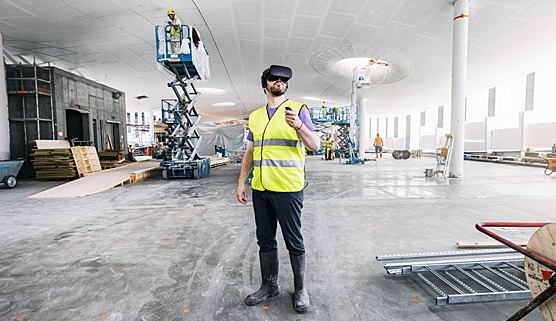
© Jussi Hellsten / City of Helsinki
In procurement, the use of a carbon footprint seems like a good idea: a numerical value to identify climate impact and guide procurement alongside costs. But how viable is the carbon footprint as part of public procurement? The Canemure subproject of the City of Helsinki is currently investigating this question.
Identify key procurement groups in terms of climate impact and get to work
Last autumn, the Finnish Environment Institute analysed the carbon footprint of the procurement and investments of the City of Helsinki. The major emission impact in Helsinki arises from construction investments and the related construction and maintenance services.
“The city must be able to better guide its service production and procurement in a low-carbon direction. The carbon footprint data helps us identify the most important actions for promoting low-carbon operations,” says Jorma Lamminmäki, Procurement Director at the City of Helsinki.
In addition to construction, the subproject also examines other emissions-intensive procurement groups. The investigation includes the Design & Build contract of wooden apartment buildings, the street and water management contract of a densely built environment, renovation of an apartment building constructed in the 1970s as well as repaving contracts.
Other examined sectors include catering services for staff canteens and residential care homes as well as meat and dairy products. The latest addition was the procurement of work uniforms.
According to Mia Malin, specialist of sustainable procurement at the City of Helsinki, carbon footprint data has already been used to develop a tool for assessing the sustainability of procurement.
“The development of low-carbon criteria will be targeted at the key procurement identified with the assessment tool. Impact monitoring in terms of emission reductions, for example, will also be developed in these procurement groups,” says Malin.
Reveal the factors constituting the life cycle carbon footprint of procurement
Unfortunately, the amount of comparable carbon footprint data available is very limited, and applying the information at a practical level is not simple. Understanding the factors impacting the carbon footprint, however, helps us understand the major sources of climate impact in procurement. This, in turn, helps us use the correct climate criteria in the actual procurement.
In the dairy product procurement, the Product Environmental Footprint (PEF) recommended by the European Commission was one of the considered solutions.
In the end, the tenderers were asked to deliver an action plan aiming to reduce the climate impact caused by the procurement. Repaving contracts are also expected to include measures reducing the climate impact and data collection for the carbon footprint calculations of future contracts.
Consider the purposeful use of carbon footprint data in procurement

© Antti Pulkki / City of Helsinki
The requirement of comparable data and the free availability of calculators makes the use of carbon footprint data in public procurements quite challenging. The consistency of the calculation method, the reliability of the initial information and the skills of the counter influence the comparability of the tenders and, therefore, the equality of competitive bidding.
The ability to use carbon footprint data in competitive bidding is a key subject of investigation. A national method for assessing the carbon footprint of buildings has been developed in Finland, and the carbon footprint of new buildings will be controlled with legislation in the near future.
The existence of a standardised calculation method enabled the comparison of carbon footprint data in the competitive bidding for the D&B contract of apartment buildings.
If carbon footprint data cannot be used in competitive bidding, the carbon footprint can be calculated during the contracting period to discover where the operations could be developed further. This was the solution chosen for the catering service procurement.
Engage in a dialogue with the market and cooperate to find a solution for climate targets
Achieving the climate targets requires cooperation. Find out how prepared the market is by openly communicating practical ideas and challenges. The private sector and cities may have surprisingly similar goals. Dialogue may help find fruitful cooperation.
The preparation of the meat and dairy product procurement was preceded by multiphase market discussion. In particular, businesses were heard about solutions for considering environmental impact and carbon footprint.
“Our goal is to reduce the emissions of procurement through environmental criteria. We’ve noticed that developing the criteria in cooperation with the market plays a crucial role,” says Procurement Director Antti Virtanen from Helsinki Service Centre.
Consider whether the climate impact can be reduced by changing the procurement method
The long-term goal is to continuously reduce the carbon footprint of procurement through both climate criteria and climate-friendly products and services. In addition, above all else, promoting low-carbon procurement requires us to reexamine our existing practices and be open to different ways of procurement.
In order to reach the city’s ambitious climate targets, the goal is to raise awareness of resource-wise procurement methods that are sensible in terms of life cycle impact. Attention will be paid to both everyday consumption of goods as well as service procurement instead of ownership. The latter is examined in terms of the city’s procurement of work uniforms, among other things.
- Use good practices! Examples of successful low-carbon procurement are available and continuously increasing. Pick the components suited for your procurement from the Commission’s GPP criteria as well as the examples of KEINO Competence Centre for Sustainable and Innovative Public Procurement and Motiva!
- Remember that the carbon footprint is only one indicator! Even though the project focuses on the carbon footprint, attention is paid to comprehensive sustainability in competitive bidding for procurement. The employment condition, among other things, is used in procurement, and special attention is paid to the sustainability of food.
Authors: Project Coordinator Satu Turula, City of Helsinki and Project Specialist Reetta Huomo, City of Helsinki
The article was published in the Hiilineutraali Suomi journal in September 2020 (in Finnish).
More information